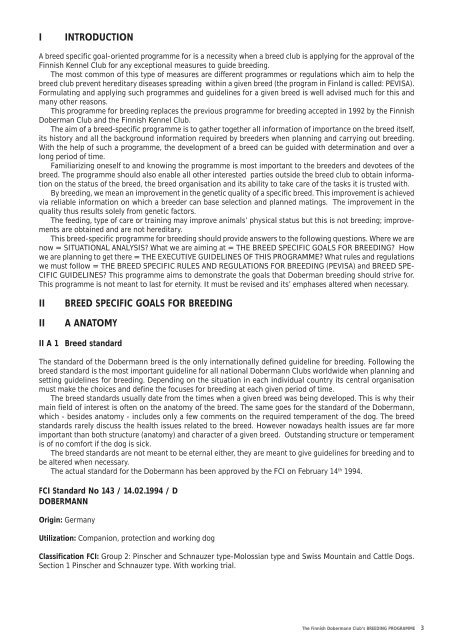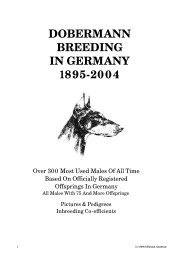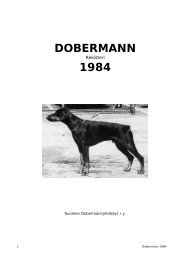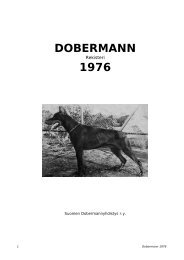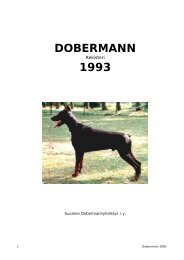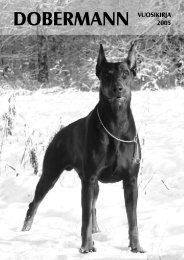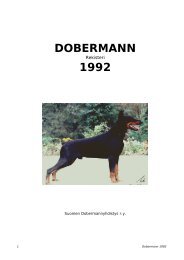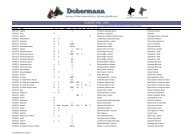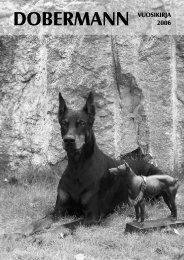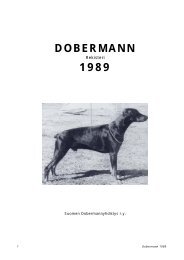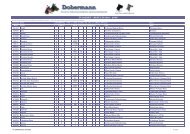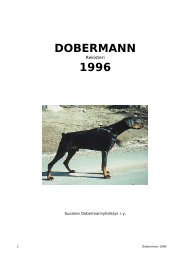Breeding Programme
Breeding Programme
Breeding Programme
Create successful ePaper yourself
Turn your PDF publications into a flip-book with our unique Google optimized e-Paper software.
I<br />
INTRODUCTION<br />
A breed specific goal-oriented programme for is a necessity when a breed club is applying for the approval of the<br />
Finnish Kennel Club for any exceptional measures to guide breeding.<br />
The most common of this type of measures are different programmes or regulations which aim to help the<br />
breed club prevent hereditary diseases spreading within a given breed (the program in Finland is called: PEVISA).<br />
Formulating and applying such programmes and guidelines for a given breed is well advised much for this and<br />
many other reasons.<br />
This programme for breeding replaces the previous programme for breeding accepted in 1992 by the Finnish<br />
Doberman Club and the Finnish Kennel Club.<br />
The aim of a breed-specific programme is to gather together all information of importance on the breed itself,<br />
its history and all the background information required by breeders when planning and carrying out breeding.<br />
With the help of such a programme, the development of a breed can be guided with determination and over a<br />
long period of time.<br />
Familiarizing oneself to and knowing the programme is most important to the breeders and devotees of the<br />
breed. The programme should also enable all other interested parties outside the breed club to obtain information<br />
on the status of the breed, the breed organisation and its ability to take care of the tasks it is trusted with.<br />
By breeding, we mean an improvement in the genetic quality of a specific breed. This improvement is achieved<br />
via reliable information on which a breeder can base selection and planned matings. The improvement in the<br />
quality thus results solely from genetic factors.<br />
The feeding, type of care or training may improve animals’ physical status but this is not breeding; improvements<br />
are obtained and are not hereditary.<br />
This breed-specific programme for breeding should provide answers to the following questions. Where we are<br />
now = SITUATIONAL ANALYSIS? What we are aiming at = THE BREED SPECIFIC GOALS FOR BREEDING? How<br />
we are planning to get there = THE EXECUTIVE GUIDELINES OF THIS PROGRAMME? What rules and regulations<br />
we must follow = THE BREED SPECIFIC RULES AND REGULATIONS FOR BREEDING (PEVISA) and BREED SPE-<br />
CIFIC GUIDELINES? This programme aims to demonstrate the goals that Doberman breeding should strive for.<br />
This programme is not meant to last for eternity. It must be revised and its’ emphases altered when necessary.<br />
II<br />
II<br />
BREED SPECIFIC GOALS FOR BREEDING<br />
A ANATOMY<br />
II A 1 Breed standard<br />
The standard of the Dobermann breed is the only internationally defined guideline for breeding. Following the<br />
breed standard is the most important guideline for all national Dobermann Clubs worldwide when planning and<br />
setting guidelines for breeding. Depending on the situation in each individual country its central organisation<br />
must make the choices and define the focuses for breeding at each given period of time.<br />
The breed standards usually date from the times when a given breed was being developed. This is why their<br />
main field of interest is often on the anatomy of the breed. The same goes for the standard of the Dobermann,<br />
which - besides anatomy - includes only a few comments on the required temperament of the dog. The breed<br />
standards rarely discuss the health issues related to the breed. However nowadays health issues are far more<br />
important than both structure (anatomy) and character of a given breed. Outstanding structure or temperament<br />
is of no comfort if the dog is sick.<br />
The breed standards are not meant to be eternal either, they are meant to give guidelines for breeding and to<br />
be altered when necessary.<br />
The actual standard for the Dobermann has been approved by the FCI on February 14 th 1994.<br />
FCI Standard No 143 / 14.02.1994 / D<br />
DOBERMANN<br />
Origin: Germany<br />
Utilization: Companion, protection and working dog<br />
Classification FCI: Group 2: Pinscher and Schnauzer type-Molossian type and Swiss Mountain and Cattle Dogs.<br />
Section 1 Pinscher and Schnauzer type. With working trial.<br />
The Finnish Dobermann Club’s BREEDING PROGRAMME 3


